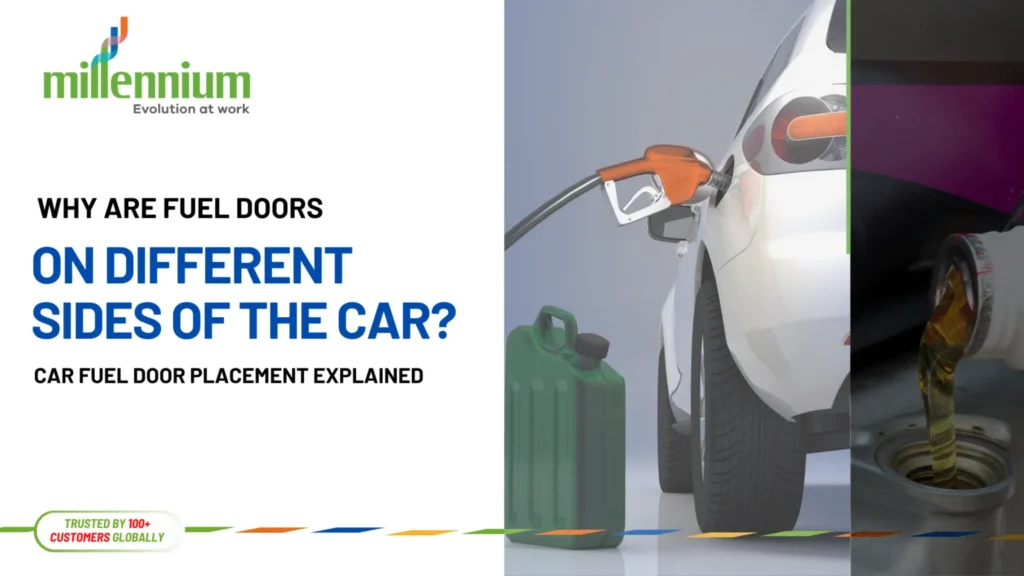When you pull into a gas station, you’ve probably noticed that not all cars have the fuel door on the same side. Some are on the left, others on the right. While this might seem like a minor detail, fuel door placement is the result of several design, safety, and convenience factors that car manufacturers carefully consider. Let’s explore why fuel doors are placed differently on various vehicles.
The History Behind Fuel Door Placement
In the early days of the automobile, fuel fillers were located in all sorts of places—under the rear license plate, behind tail lights, even in the middle of the trunk. Safety regulations were lax, and convenience wasn’t always top of mind. As vehicle design evolved, especially in the 1950s and 1960s, automakers began standardizing fuel tank locations and filler caps to improve safety and usability.
By the 1970s, rear-mounted filler necks were largely phased out due to safety concerns in rear-end collisions. This led to a shift toward placing fuel doors on either the left or right side of the vehicle, depending on the layout of the fuel tank and other components like the drivetrain or exhaust system.
Why Do Some Cars Have Fuel Doors on the Left and Others on the Right?
There is no universal regulation mandating which side the fuel door must be on. The decision largely depends on a few key factors:
1. Manufacturing and Design Efficiency
Automakers often produce vehicles for both left-hand and right-hand drive markets. Placing the fuel door on one consistent side allows them to streamline production. For example, many European and Japanese cars have the fuel door on the left because that’s the driver’s side in right-hand drive countries like the UK and Japan. This makes it more convenient for drivers to refuel without stepping into traffic.
In contrast, many American-made vehicles have fuel doors on the left because drivers in the U.S. sit on the left side of the car. This symmetry makes it easier to judge proximity to the pump and reduces the risk of door dings in crowded gas stations.
2. Safety Considerations
Fuel door placement also considers crash safety. Designers aim to position fuel tanks and filler necks away from potential impact zones. If the exhaust system or rear suspension takes up space on one side of the vehicle, it may push the fuel door to the other side.
Additionally, placing the fuel door on the curb side (typically the right side in right-hand drive countries and the left side in left-hand drive countries) can make refueling safer, especially if a driver needs to exit the vehicle on a busy road.
3. Fuel System Layout and Packaging
Sometimes, the decision comes down to how the components inside the vehicle are arranged. The fuel tank, filler neck, and evaporative emissions system must all fit within a confined space. Engineers aim to minimize the complexity and cost of routing these systems. The side that offers the most direct and efficient packaging will usually get the fuel door.
How Does Fuel Door Placement Affect Drivers?
While the average driver may not think about it often, fuel door placement can influence the overall refueling experience.
1. Refueling Convenience
Drivers often prefer having the fuel door on their side, as it provides better visibility and makes it easier to align the car with the fuel pump. However, this isn’t always possible depending on the make and model. This is why modern cars include a small arrow on the fuel gauge to indicate which side the fuel door is on.
2. Gas Station Traffic Flow
Fuel door placement affects how vehicles maneuver around gas stations. If too many cars have the fuel door on the same side, it can create congestion during peak hours. Some drivers may have to stretch the pump hose around their vehicle, which is not ideal and may even be dangerous if done carelessly.
3. Rental Cars and New Vehicles
Not knowing which side the fuel door is on can cause minor frustration, especially when driving a rental or a new vehicle. Thankfully, most cars now feature that helpful fuel gauge indicator arrow to eliminate the guesswork.
Conclusion
Fuel door placement may seem like a small detail, but it’s influenced by a blend of design logic, manufacturing constraints, safety regulations, and user convenience. Whether your fuel door is on the left or right, there’s a practical reason behind it.
So next time you’re at the pump and notice a car with the fuel door on the opposite side from yours, remember—it’s not random. It’s a carefully considered part of vehicle engineering. And if you’re ever in doubt, just check the little arrow next to the fuel pump icon on your dashboard—it’s your best friend at the gas station.


